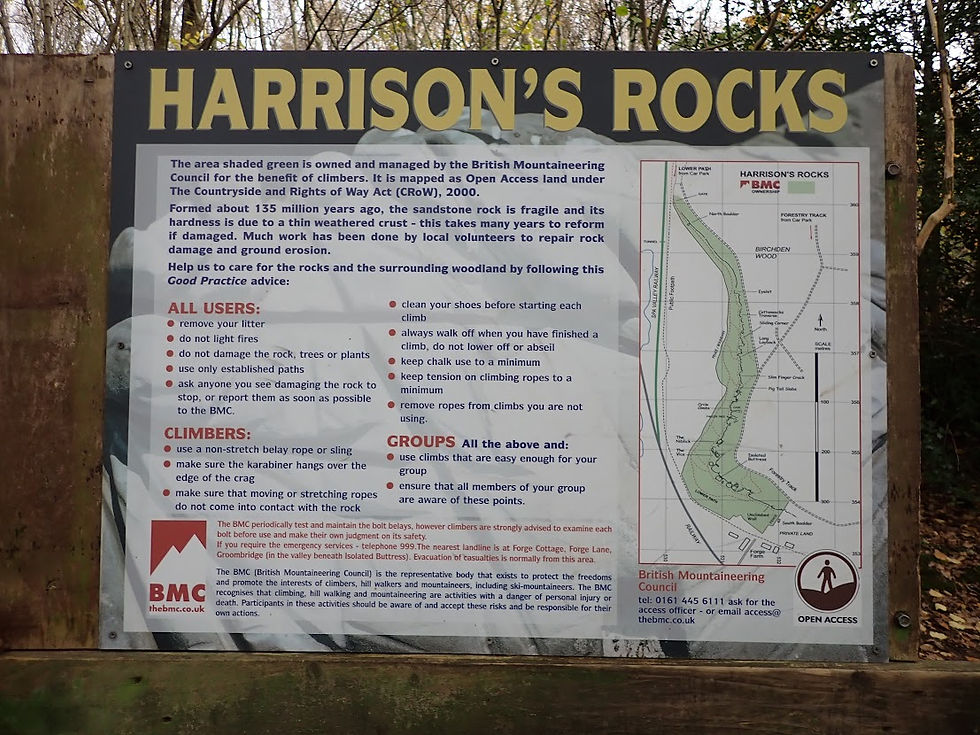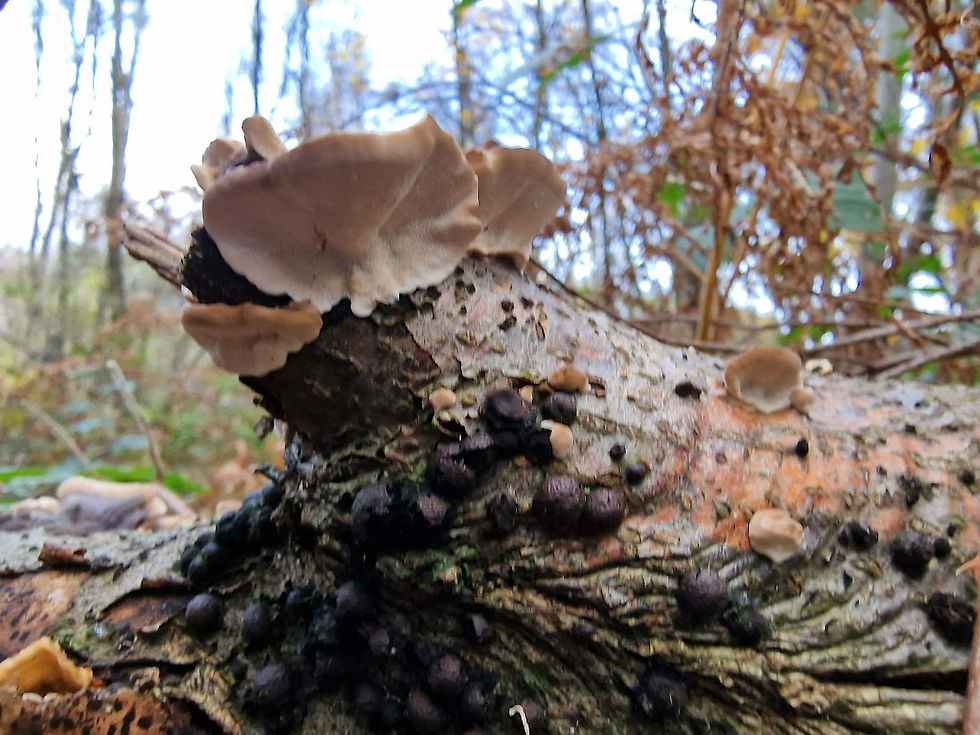Harrison Rocks/Birchden Wood. Fungi, Lichen, Moss, Liverworts & Slime Mold. 26.11.22
- Sim Elliott
- Nov 27, 2022
- 3 min read
Updated: Nov 29, 2022
Harrison Rocks (British Mountaineering Council are the western edge of Birchden Wood (Forestry England); which is west of Eridge (East Sussex) and just south of Groombridge (Kent). I reached them by catching the 29 bus (once an hour; two hour journey time) from Brighton to Eridge Green and then walking along the High Weald Landscape Trail, which passes the southern entrance to Eridge Rocks Nature Reserve (Sussex Wildlife Trust). From Eridge Green church I walked along the High Weald Landscape Trail to Birchden Woods - it is a very easy route to take.
See:

Map from: file.html (highweald.org)
High Weald Landscape Trail from Eridge Green to Birchden Wood
Crimped Gill or Crispling, Plicaturopsis crispa.

Common Greenshield Lichen, Flavoparmelia caperata

Oak Curtain Crust, Hymenochaete rubiginosa

The High Weald Landscape Path

Hariy Curtain Crust, Stereum hirsutm


A Ghyll

Darker green: possibly Common Mushroom-headed Liverwort, Preissia quadrata

Common Jellyspot, Dacrymyces stillatus on a style. A tiny fungus; the fruiting bodies of this example were only about 2mm across.




The path to Birchden Wood

Stereum sp. fungi probably Yellowing Curtain Crust, Stereum Stubtomentosum



Probably Bank Haircup, Polytrichastrum formosum

Mire woodland

Harrisons Rocks

Beautiful and unique rock architecture which provides challenging climbing across the grades is the stand out feature of this incredibly popular South East crag. The intricacy of movement its routes require and stunning woodland setting transport you into another world and it’s easy to imagine you’re a character in a folk tale long ago as you wander around below the crag. Harrison's Rocks (thebmc.co.uk)

Harrison's Rocks are formed of the Ardingly sandstone of the Tunbridge Wells Sand Formation deposited in the early Cretaceous
A human-cut passageway, with rock steps, through the rocks to the base of Harrison's Rocks


In 1981, Doctor Who was filmed at Harrison's Rocks. It was Peter Davison's first transmitted story, Castrovalva. Harrison's Rocks - Wikipedia

Probably Trentepholia sp. alga




Heather growing in cracks in the rocks.


Black Spleenwort, Asplenium adiantum-nigrum. A fern


A Pellia species Liverwort, probably, Pellia endiviifoliaL Liverworts excrete a form of oily fluid on their leaves that makes them refractive of sun light and thus very difficult to photo well. Don't use flash!

Lverwort, (division Marchantiophyta); More than 9,000 species of small nonvascular spore-producing plants. Liverworts are distributed worldwide, though most commonly in the tropics. Thallose liverworts, which are branching and ribbonlike, grow commonly on moist soil or damp rocks, while leafy liverworts are found in similar habitats as well as on tree trunks in damp woods. The thallus (body) of thallose liverworts resembles a lobed liver—hence the common name liverwort (“liver plant”). The plants are not economically important to humans but do provide food for animals, facilitate the decay of logs, and aid in the disintegration of rocks by their ability to retain moisture. liverwort | plant | Britannica


Common Ragwort, Jacobaea vulgaris; flowering very late in the year



To be identified


A Caldonia sp lichen

Shrek's Ears. No, Humble Pixie-cup Lichen. Cladonia humils. I think. Cladonia species are hard to differentiate between.








Birchden Wood



Brrom fork-moss, Dicranum scoparium


Probably Neat Feather Moss, Pseudoscleropodium purum

Cypress-leaved plaitmoss, Hypnum curpressiform. Mosses have a capsule, where the sporangia (enclosures in which spores are formed) are housed. This capsule has a lid-like structure called an operculum, which pops off when spores have matured. In this photo operculi are the lighter brown parts of the darker brown capsules,

Oak leaves and acorns in a pool in the hollow of the roots of an upturned tree


Photographing a slime mold.

The fruiting bodies of Ceratiomyxa fruticulosa (no common name); a slime mold


Reference photos to get a feel of the size of this slime mold.





Turkeytail

Turkeytail, Tramestes versicolor




Hard Fern, Blechnum spicant


Beetle catcher; to monitor beetles, and check for non-native invasive species.

The Deceiver. Laccaria laccata, of four different sizes i.e. fruiting bodies from the same mycelium




Comments